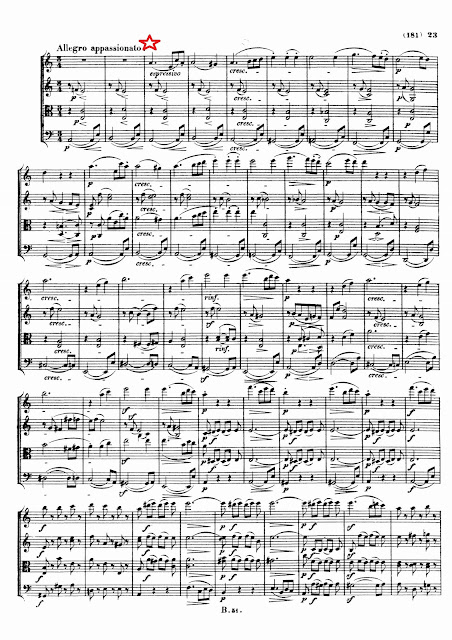DLIV. BEETHOVEN, Ludwig van (1770-1827)
Beethoven was very ill. His doctor instructed him to forego wine, coffee, and spices. On May 7th, he quit Vienna and went to Baden to get better. As was his habit, he enclosed a canon (WoO 189) in his letter to the doctor:
Thus, we have the glorious third movement, composed as a "Holy song of thanksgiving of a convalescent to the Deity, in the Lydian Mode."
First movement
A tetrachord is a group of four notes. A scale is composed of two tetrachords:
First movement
A tetrachord is a group of four notes. A scale is composed of two tetrachords:
In this A Harmonic Minor (the 7th degree is raised), we will concern ourselves with the second tetrachord.
Beethoven uses this to begin this work (and reused it in many places in these Late Quartets). He puts these four notes in an unusual pattern: G# (3) / A (4) / F (2) / E (1) ...
So the quartet begins -- not on the tonic A, as would be normally expected -- but on the leading-tone G-Sharp. This will shape much of the music in the entire quartet.
The first violin twirls out the beginning of the Allegro -- Beethoven inserts one bar of Adagio, and then they're off ...
As if to lighten the mood, Beethoven soon moves to the VI (F Major):
Beethoven then repeats the pattern, moving up a fifth -- first to E Minor:
then to C Major:
After returning to A Minor for good, the movement closes with a rumbling dominant pedal point, and ends with a march-like insistence.
Second movement
Again, Beethoven begins this lilting A Major movement (a minuet and trio) on the leading-tone:
The trio features an A pedal tone, first on the violin, then the others, which creates a sound reminiscent of bagpipes or hurdy gurdies.
Third movement
The Lydian Mode is an F Major scale with the fourth degree raised from a B-Flat to a B-Natural.
The form alternates between the church-like Lydian and a more vigorous D Major (Neue Kraft fühlend = feeling new strength):
Time stands still.
Fourth movement
And this brief little march breaks the serenity -- and with a little recitative-like section leads directly into the finale:
Fifth movement
From Beethoven's sketchbooks, we learn that this theme was originally meant for an instrumental conclusion to the Ninth Symphony (Post C).
In sonata rondo form (A B A C A B A).


















No comments:
Post a Comment